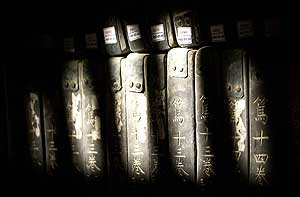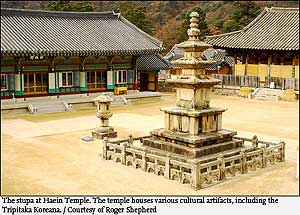
|
|
|
Home Asia Pacific North Asia S/N Korea Temple Stay Haein Temple - Third Jewel of Korean BuddhismBy Roger Shepherd, The Korea Times, Dec 22, 2009South Gyeongsang Province, South Korea -- Haeinsa, or Haein Temple, is one of Korea's Three Jewel Temples and it was to be the last one of those three that I would visit.
The jewel that Haein Temple is famous for is the Tripitaka Koreana, a complete composition of Buddhist scriptures (Dharma) that have been hand carved onto 81,258 wooden printing blocks. This feat has made Haein Temple a World Heritage Site listed by UNESCO.
Situated in the stunning Mt. Gaya National Park area in Hapcheon, South Gyeongsang Province, some 70 kilometers west of Daegu, the temple's grounds are locked safely under the rugged mountain peaks of Sangwang-bong (1,433 meters) and Chulbul-bong (1,430 meters). The geographical feature helped Haein Temple defend the Koreana Tripitaka against marauding Japanese forces during the late 16th-century invasions of Korea. The temple was founded in 802 A.D. by Masters Su Neung and IJeong. They supposedly returned from China and assisted in the healing of King Aejang's wife where the temple site is now located. Legend has it that the two monks tied a silk cloth around the queen's body and attached the other end to a nearby tree. The queen was healed of her illness, and the tree subsequently died as a result of the transfusion. Haein Temple is home to many other relics and treasures, including the "Haein-do" located in the middle of the temple grounds. It is a square-shaped maze with a stone pagoda in the middle, where monks and visitors to the temple walk through the design as a form of walking meditation or prayer to realize their wishes. I was in Haein Temple to attend the templestay program and even though it was still only mid-November, the high altitude temple was putting on an icy reception weather wise, with flakes of snow trying to form on the cold hard ground. On this program was a group of eight foreigners that had formed up in a nearby room next to the templestay office. Three monks hosted the event. Ven. Jung Han was a fluent English speaker who had spent some time in the United States before deciding to return to Korea and become a monk. The program began with a translated introduction from a veteran Buddhist senior monk named Ven. Myeong Kang. He had a rather hard-looking demeanor about him as his message was translated to the group. He emphasized that templestays at Haein Temple are not fun events but more an opportunity for us to see how monks live.
One interesting point was brought up on whether anyone had any strong enough religious beliefs not to bow to Buddha. If so the monks explained what bowing to Buddha was all about. When you bow to Buddha, you are bowing to the Buddha inside you and the universe. Buddhism always believes that everyone has the ability to be a Buddha and that we all possess it. From there we were all taken bravely outside into the icy mountain air on a tour of the temple. During the many stopovers at the various relics and attractions of the temple site, the open-minded and friendly Ven. Jung Han would narrate to the group his understandings of Buddhism. This brought about a nice flow to the tour as we were all able to take in the sights, and then the sounds of Buddhism according to him. He had decided to expand on what Ven. Myeong Kang had said, and spoke of the hardships of temple life when studying as a recruit and then later as a graduate at Haein Temple. When asked what was one of the best traits he had acquired as a recruit, he replied that he was grateful for the art of learning patience. He mentioned that he didn't truly find out what patience really was until he had developed the desire to lose himself or his own feelings by literally switching off during some of the physical and studious ordeals of his training ? an ability to stop feeling sorry for yourself. Ven. Jung Han explained how the massive wooden tablet collection took 16 years to accomplish (a short period I thought) under the workmanship of over 1 million people, signifying to Korean Buddhism the power and sincerity of the collective works. He concluded that if the entire collection was stacked, it would stand higher than Mt. Baekdu at 2,744 meters. He then spoke of the building and how, due to the composition of the foundations to the building, there were no insects or spiders within the interior of the 800-year-old structure. After dinner and the evening prayer service the group returned to the warm study hall to conduct a casual tea ceremony. While brewing and passing around pots of hot Korean tea, Jang Han continued to answer questions from the curious foreign participants. He spoke of the possibility of knowing oneself better through Buddhism, how once closer to that we could become freer from suffering and really begin to understand who we are. When in that state of "Buddha," you learn not to be afraid of anything, not even death. He stated that you should know yourself before you die; shouldn't everyone want to know who they truly are if given long enough to live? We then talked about meditation and asked him to explain it further. He talked of how science had discovered that when one is meditating the energy created is similar to that of sleep, which is something we all need to re-energize. He expanded by saying that there are some monks that are so great at meditation that instead of sleeping they meditate in a sitting or standing position ? now this I found even more interesting, but strangely convincing in the magical confines of Haein Temple. Ven. Jung Han spent the rest of the evening talking to the group about many other interesting topics, but one of the things that I remembered the best was his comment on love and attachment. Buddhism strongly emphasizes the importance of being desireless and detached from everything; that way you learn not to suffer when it has gone. He said that when you have learned not to love one thing or a particular object or possession, then you are able to love everyone and everything. The next morning when we all left I came to the conclusion that the deep and interesting conversational opportunities the group was given during the one-night templestay program really added a meaningful and understanding experience for us. There was also the enjoyable program consisting of Evening and Morning Prayer service, a meditation session, a mountain hike, some Buddhist craft work and an educational temple tour. Having Ven. Jung Han and the hardened disciplinarian mannerisms of Ven. Myeong Kang really made the participants feel and understand the power and eminence of this great and famous temple. The hard icy mountain conditions and fortifying features of Mt. Gaya gave Haein Temple the overall sensation of it being a high-altitude, warrior-like monk bastion that only privileged ones could reside ? indeed we felt fortunate to be there, and when we left we felt like we had a better understanding of Buddhism and what it must be like to train at and graduate from Haein Temple, the Dharma Jewel of Korean Buddhism. To get to Haein Temple you can take the Haein Temple bus from the West Daegu Intercity Bus Terminal located near the Seongdangmot subway stop on Line 1. There are also buses that go to Haein Temple from Gochang, Hamyang and Daejeon. For more information, visit www.haeinsa.or.kr. |
 |
|
| Korean Buddhist News from BTN (Korean Language) |
|
 |
|
|
Please help keep the Buddhist Channel going |
|
| Point
your feed reader to this location |
|

 << Haein Temple, located in South Gyeongsang Province, houses the Tripitaka Koreana, one of the National Treasures of Korea registered as a UNESCO Cultural Heritage. The Tripitaka Koreana, consisting of more than 80,000 wooden blocks, was made in 1251 and is considered to be the most complete, comprehensive and best preserved version of Buddhist canon.
<< Haein Temple, located in South Gyeongsang Province, houses the Tripitaka Koreana, one of the National Treasures of Korea registered as a UNESCO Cultural Heritage. The Tripitaka Koreana, consisting of more than 80,000 wooden blocks, was made in 1251 and is considered to be the most complete, comprehensive and best preserved version of Buddhist canon. With that the participants learned throughout the introduction period that Haein Temple had a reputation as being a very strict place with about 200 monks currently residing there, and a total of 500 in the entire Mt. Gaya region.
With that the participants learned throughout the introduction period that Haein Temple had a reputation as being a very strict place with about 200 monks currently residing there, and a total of 500 in the entire Mt. Gaya region.

